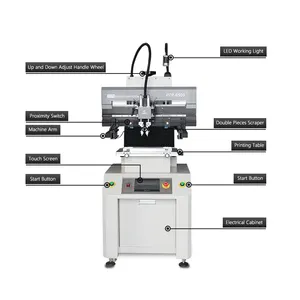
PTR-B500 Solder Paste Printer Desktop Pcb Printer Double Scraper Semi-Automati Solder Paste Stencil Printer For Smt Production


Automatic No Clean Lead Free Solder Paste Heating Equipment Smt Solder Paste Warm Up Machine Temperature Back Machine























Surface Mount Device (SMD) solder paste is a fundamental material used in the electronics assembly industry. It is a form of solder used in the reflow soldering process to attach electronic components to printed circuit boards (PCBs). The paste is a blend of solder powder and a specialized flux, which facilitates the soldering process by removing oxidation from the surfaces to be joined.
The composition of SMD solder paste is critical to its performance. Typically, it consists of a mixture of metal alloys, commonly tin, silver, and copper, which determine the melting point and wettability of the paste. The types of solder paste are categorized based on their particle size and flux composition, which can affect the flow and reactivity of the paste during the soldering process. Users can select from various formulations to suit specific applications, whether for intricate microelectronics or larger-scale assemblies.
The primary application of SMD solder paste is in the attachment of components to PCBs. It is suitable for a range of soldering techniques, including reflow and selective soldering, making it versatile for different manufacturing requirements. The paste is carefully deposited onto the PCB pads, where components are placed before the entire assembly is heated to create solid solder joints.
One of the key features of SMD solder paste is its ability to create reliable and strong electrical connections. Its formulation allows for precise application, which is essential for the ever-decreasing sizes of electronic components. The flux within the paste is designed to prevent oxidation during soldering, ensuring clean and effective joints. Moreover, the paste's rheology is optimized for excellent printability and tackiness, which is crucial for holding components in place before soldering.
Modern SMD solder paste formulations are mindful of environmental impact, with many manufacturers offering lead-free and halogen-free options. These eco-friendly alternatives provide the electronics industry with choices that align with environmental regulations and corporate sustainability goals.
Proper storage and handling of SMD solder paste are essential to maintain its efficacy. The paste should be stored at controlled temperatures to preserve its shelf life and performance characteristics. Users should follow the manufacturer's recommendations to ensure the paste delivers optimal results during the soldering process.
In conclusion, SMD solder paste is a specialized material designed for creating strong, reliable solder joints in the assembly of electronic components. Its various formulations cater to different soldering requirements, making it a versatile choice for electronics manufacturing. With an emphasis on environmental responsibility, the industry continues to innovate, providing eco-friendly solder paste options for a sustainable future.